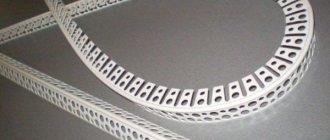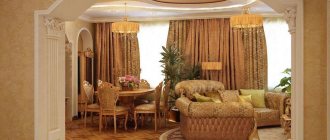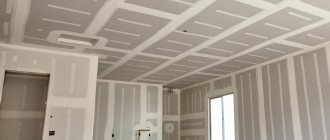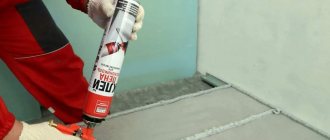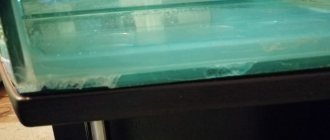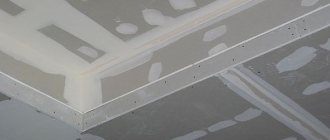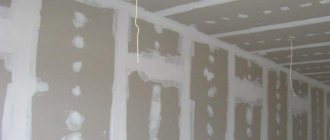Home renovation is a desire for beauty and comfort. And it’s not scary if the walls are not level or there are differences in plane. The main thing is that it is visually smooth and beautiful. How to achieve this?
Few people know that the secret to the visual beauty of walls lies in a straight, clear edging. This concept refers to the following areas of application of plasters and putties:
- external and internal angles;
- junctions of walls at ceilings and floors;
- protruding parts of any structures (arches, boxes, other structures).
All these places (edges) must correspond to the intended design. Straight should be straight, oval should be oval. The former plasterer-painter achieved acceptable quality with almost his bare hands. But modern accessories simplify and speed up the process.
In fact, all of them are perforated corners for plaster. There are only two varieties of it - straight and arched, and there are many more subspecies. They are used almost everywhere where plaster mixtures with putty are used.
Right angle.
A right perforated angle can be used for internal and external corners. It can be of different widths, as well as aluminum, galvanized or plastic (polyvinyl chloride). In general, there is no difference. You can’t say that one is better or worse. But galvanized corner is more rigid than others. Especially the wider one. Therefore, it is convenient to use it as a plaster beacon.
Tip: Use good, sharp tin snips to cut the corner, as the bent edges will get in the way. On the other hand, plastic products can be cut perfectly with a regular stationery knife. If you don’t have a knife, scissors, or grinder at hand, then you can simply break the perforated angle. Uneven edges can be easily straightened with pliers, a hammer or just your fingers.
Any straight corner for plastering corners is a V-shaped profile. Its sides (shelves) have many holes throughout their entire plane - perforation. The top of the corner stands out, that is, it sticks out relative to the shelves by approximately 1 mm. Moreover, at the inner corners it sticks out inward, and at the outer corners it sticks out. Perforation is needed for reliable fastening, the top is like a guide for a spatula.
Tip: In order to cut a dozen perforated corners of the same length, you can fold them one into one, then, after measuring with a tape measure, cut off the entire pack, say, with a grinder. And 2-3 pieces will be cut through by metal scissors.
The purpose of the perforated corner and how to install it
Depending on the task at hand, this finishing accessory can be installed in two ways: on a curved corner and on a leveled one.
Installation of corners on drywall using corners
When starting to install a corner on drywall, you need to have tools and material on hand.
Required material
- the selected type of corner will need to be purchased with some reserve;
- using a primer, the surface of the drywall is strengthened;
- It is best to buy Vetonit putty, which is of high quality.
Tools
- metal scissors will help you cut out the necessary parts correctly and quickly;
- a brush that will be needed to apply the primer;
- wide and narrow spatulas will be needed for puttying drywall;
- The sanding block will remove all unevenness on the plane, while the angle will be perfectly even.
This is what mounted corners on drywall look like.
When starting installation, you need to familiarize yourself with the sequence of leveling the corners with putty so as not to damage this fragile material.
Stages of work
- First, the surface must be thoroughly cleaned and treated with a primer. You need to proceed to the next stage only after it has completely dried.
- Measurements are taken and the required length of the corners is cut. They are applied to the drywall as a sample.
- For further work, you will need non-woven tape, serpyanka mesh for the internal corners, one of the types of perforated corners: plastic, adhesive, rounded, either made of a metal profile or paper-based.
- Before you putty the gypsum plasterboard corners, you should select a putty for the gypsum plasterboard. To form internal and external corners, it is better to buy a dry gypsum mixture. It has a reasonable price, good quality and can securely fasten elements to the structure.
- The putty is prepared following all the steps: poured, poured, stirred, allowed to settle, kneaded again.
- When working with external corners, you need to remember that they are most often subject to mechanical stress; it is better to mount metal samples, in some cases having a rounded shape.
- Check the flatness of the end.
- Putty is applied to the area to be treated with smooth movements. Without allowing the composition to dry, you need to secure the corner with pressure, check the accuracy with a level, and if necessary, you can tap with a rubber mallet.
- Sometimes the corner is attached to the drywall with a stapler or glued with glue, and then covered with putty.
- Another layer of the mixture is applied to the installed element and now alignment occurs with the general plane of the wall.
The corner is a beacon.
In the first case, the product will serve as a plaster beacon. To install it, a plaster mixture is applied to the base corner. By the way, it is more convenient to work with gypsum plaster than with cement plaster. It should not be applied along the entire length of the edging, but in such flat cakes - for the convenience of adjusting the angle along the plane and level. This adjustment is made using a building level and a plaster rule.
Tip: If you add a handful of cement or any cement mixture to gypsum plaster, the plaster beacon will set in a matter of minutes. You can continue working immediately. Where perpendicular planes intersect, it is advisable to cut the overlapping corners at 45 degrees to avoid overlap.
It should be noted that the internal perforation angle is extremely inconvenient to use as a beacon for plaster. It is only suitable to emphasize the straightness of the edging.
In walk-through areas where external corners may be subject to more intense mechanical loads, it is recommended to install a corner with a mesh under the plaster. Fiberglass plaster mesh, firmly connected to a plastic or metal corner, serves as a means of reinforcing the corner.
This type of perforated corner is used precisely as a beacon. After all, it is almost impossible to hide the mesh under a layer of finishing putty, since about 5 mm of plaster must be applied on top of it
Advice: If you want to reinforce a regular perforated corner, you can cover its shelves with a sickle mesh, covering the wall. Strips of non-woven fabric or fiberglass are also perfect for this purpose. The same putty can be used as glue.
Characteristics of the corner profile
The purpose of using the material is to strengthen and protect slopes and corners from mechanical damage. It is made of plastic or metal. There are perforations (holes) along the entire length.
The profile can have a reinforcing mesh on both sides. Such building material will adhere securely to the surface after installation.
The corner profile is used to protect corners on plasterboard structures, to strengthen window slopes, doorways, etc. With its help, it is quite easy to give the correct vertical line to the outer corner.
Profile installation
To strengthen and level the corners, purchase the required amount of material. To calculate its consumption, measure the length of each section with a tape measure. Sum everything up and add 10% of the result obtained to the treated value. This measure is necessary, since it is much more difficult to work with small pieces.
- Installation of a metal perforated profile is carried out during the process of leveling the walls. The preliminary step is priming the work area. While the soil dries, the painting corner is shortened to the required size.
- After this procedure, we prepare a solution on which the material will be planted (starting putty, tile adhesive). The mixture is kneaded in a clean container using a mixer. It should look like thick sour cream. A mixer is a special attachment for a drill.
- The time has come to apply the prepared solution over the entire length of the working area and on both adjacent sides. Now you need to attach the profile to the treated area. It is pressed into the solution so that the mixture appears through the perforation. Remove excess solution from the end of the material.
- The verticality of the corner is checked with a building level. Until the mixture sets, adjust the position of the building material. Having achieved the desired result, remove excess putty on adjacent surfaces. Leave everything until completely dry.
- After the plaster has dried, remove any imperfections using a fine-grained emery cloth. The final leveling will take place along with the application of finishing plaster to the main surface (walls, ceilings).
How is a plastic corner installed?
The work of installing a plastic analogue to a plasterboard structure is performed a little differently. It is secured to the work area with a construction stapler. The putty is applied on 2 sides over the profile. The surface is leveled with a spatula, and excess solution is removed. The last stage of work is the elimination of minor defects and the application of a finishing layer of putty.
A detailed description of the installation of a corner profile will help solve the problem with corners and slopes once and for all. They will be under the reliable protection of this material.
- After thorough drying, the slope corner is polished.
- Installing corners inside the structure looks similar, even a little easier. Carefully coat the adjacent sides and the gap between the corners with a spatula, and remove excess mixture. A reinforced tape having the desired shape is glued onto the dry, sanded surface. You can also buy a serpyanka mesh, just apply it to wet putty.
- Using a building level, check the fastening of the corner on the plasterboard, then use the next layer to hide the unevenness.
- After thorough drying, the surface is finished with sandpaper or a sanded block, forming a perfect angle.
- To facilitate the leveling process, so-called beacons are used, attached to the surface with a plaster solution; here you can do without fastening parts.
- Separately, I would like to mention the semicircular plastic corner, used in rooms with the maximum possible impact on the corners. It is made of flexible plastic and has a semicircular angle rather than an acute one. Its price is quite reasonable, and its durability is beyond doubt. It differs in some features at the installation stage, namely cutting the end by 1.5-2 cm with an angle of 45 ͦ . A corner is pressed into the applied initial putty, fixed with a stapler, and the edges are treated with the mixture.
A video of arranging corners will help you see how parts of drywall are reinforced, and will also allow you to select and buy the necessary elements.
Finishing internal and external corners will not seem difficult with the right approach and the necessary training. The main thing is that during installation, smooth walls of plasterboard without a frame must be made, requiring minimal finishing.
Corner - protective cover.
If the wall, along with all its corners, is already well-plastered, then the purpose of the perforated corner will be to protect the corner from mechanical damage and emphasize a straight line.
The technology for its installation is basically the same as the first option. Only the layer of the solution used should be minimal, the consistency of the mixture should be more liquid.
To achieve this goal, a plastic or aluminum corner for plaster is ideal. In addition, it is not at all necessary to fix it with a plaster mixture or putty. After all, the base is already straight, which means that the corner should be pressed tightly against the base, hugging it.
Such installation is possible using small screws, nails or staples. You just need to make sure that the corner itself and its shelves are not deformed in the process.
Tip: Often, protruding screws and nails interfere with puttying with their heads. To avoid this, they can be removed after the corner has set.
In addition, installation of a perforated corner with a minimum layer of mortar is necessary, as a rule, when finishing gypsum plasterboard structures. Of course, provided that they are assembled with more or less high quality.
In this case, a self-adhesive perforated corner is perfect - it has strips of glue on the inner sides of the shelves, which are activated by ordinary water. If there is a need to join corners, it must be done using the same materials: plastic ones are connected to plastic ones, etc.
The fact is that different corners for plaster may differ in size, which will affect during finishing.
Level installation of painting corners
There are two methods for installing corners: first, putty is applied and then a profile is mounted on top, or first, the profile is fixed to the corner and only then “frozen” into the putty. I think the second option is more correct and convenient, and we will discuss it.
The exception is installation on a concrete base, when the self-tapping screws for temporary fastening cannot be screwed into the base - in this case it will be more convenient to place the corner directly on the putty.
It is recommended to manually make the plastic corner sharper before installation: bringing the “wings” together and walking along its entire length. The profile itself already has an angle of less than 90 degrees from the factory, but this is often not enough and it is better to immediately bend it even sharper.
The main thing is not to break the profile, and if it turns out to be very sharp, it’s okay, because it’s easy to make it “dumber” during installation, but “sharpening” it during installation is almost impossible.
In a good option, the corners are installed when the walls are leveled (with plaster), when there is already an established wall geometry. In some cases, the profile can be installed on pre-curved walls, and then stretched with putty on both sides of the evenly placed corner. There are plenty of options.
The first step is to secure the profile to the corner using self-tapping screws, small nails, etc. This is the most labor-intensive process on which the future geometry of the corner depends.
Installation involves simultaneous alignment in several planes: on both walls, their planes should not protrude due to the “spike” recesses, and the entire profile should be even in two projections.
A spatula is used to control the correct position of the profile relative to the plane of the walls. When the spatula is leaning against one wall, fasteners are fixed into the other, then the same is done with the second wall.
Here the task becomes more complicated: you need to press the profile as close as possible to the corner, but at the same time, there should be at least some minimal gap on the “wings” for the putty.
The straightness of the profile, namely the “spike,” can be checked using a rule or a long level. If a vertical angle is made from floor to ceiling, then the best option would be a rule that is slightly less than the entire height of the room. The 2 meter rule can be considered universal. Shorter rules or levels can of course be used, but they will give a larger error.
Straightness is checked alternately from the side of each plane. There is no point in applying the rule to the end of the corner in the middle (as in the diagram above), because this will not give a real picture.
Even on well-plastered walls, with a perfectly straight profile from floor to ceiling, there may be areas where the plane of the wall protrudes beyond the “thorn” of the corner when controlled with a spatula. Therefore, it is better to measure both angle planes in advance and start installation from the most protruding areas.
If you have a laser level, it is convenient to project a laser line on one side and use the rule on the other - this will simplify the work somewhat. In addition, the laser line is convenient to use on long sections where the rule will have to be rearranged. The line should be projected from the side that will be more noticeable in the interior of the room.
After placing the corner, it must be carefully covered, without knocking down the fastening screws. For this purpose, it is better to use gypsum putties, for example “fugen”. You can, of course, use polymer putties, but: the layers are usually more than 2 mm, so the layer will take a long time to dry; polymer ones have less strength and the angle will have weak mechanical strength.
The space of the “wings” where there is no temporary fastener is filled; after setting, the screws are removed and the vacant areas are filled. Well, then the final finishing is carried out according to the planned project.
I think we can draw the line at this. I would like to add: painting corners with recesses for wallpaper are used not only on external corners, but also in pairing different finishing coatings, both in internal corners and on straight sections. But this is a topic for a separate publication.
A direct joint between a wall for wallpaper and brickwork for painting will look better. The damaged blade will not be adjacent to the bricks, but to the top of the corner, which acts as a separator.
Rate this publication:
- Currently 4.00
Rating: 4.0 (2 votes)
Plastering slopes.
Slopes on windows, doors and other openings are especially important places, since a person looking there automatically compares them with a window or door. That is, with straight lines. This means that no deviations are allowed - deviations from the lines of the window or door. As for matching the level, the windows can easily be slightly blocked.
Therefore, slopes are plastered mainly according to level. It is recommended to use a corner for plastering slopes. And, again, as a plaster beacon. If the slopes were mounted from gypsum fiber board or gypsum board, and not of very high quality, then a perforated corner will help eliminate all the shortcomings.
By the way, before installing gypsum plasterboard or sandwich panels on slopes, the basic brick slope, according to technology, must be covered with plaster. The perforated corner installed at the same time will help to correctly align the sheet of drywall.
Purpose of perforated corners
What are perforation angles?
A perforated corner is a special device that acts as a frame for applying putty. A solid base allows you to achieve ideal geometry in both horizontal and vertical planes.
Among other things, a perforated corner for wall corners performs a protective and strengthening function. Fixed to the wall under wallpaper or another type of covering, this detail prevents premature destruction of the wall due to damage when carrying furniture, being hit by a heavy object, or frequent contact with the body of household members.
Material of manufacture
Currently, manufacturers produce many modifications of corners for wall putty. The purpose of the perforated corners for putty is determined by the base material and the shape of the product. Various materials are used as raw materials for their manufacture, each of which has a unique set of characteristics.
Arched corner.
Everything is clear with the finishing of right angles. How are various arches, multi-level ceilings and other figured structures brought to perfection? After all, neither the plaster rule, nor the building level, nor even a straight perforated angle will help here.
For this purpose, a slightly modified perforated corner for plaster is used - arched. Firstly, such a corner is always plastic. Secondly, one of its shelves is cut crosswise into petals. This solution allows this accessory to be so flexible that it can follow the shape of almost any smooth curves.
Tip: When installing arched corners under plaster, you need to remember that you cannot adjust them with a level or rule. This is done exclusively visually, by eye. Help from another person and good lighting will be a good help. Before installing the corner, you need to compress it a little so that the petals do not stick out from the plaster.
The arched corner, depending on the manufacturer, can be hard or soft.
Hard is usually more expensive. But, when finishing large-scale structures with smooth shapes, it is indispensable. The fact is that his desire to straighten ensures the ideal roundness of the lines and the absence of “angularities”. But attempts to use such a corner on small decorative elements with sharp bends will lead to its fractures, which cannot be corrected.
A soft arched perforated corner for plaster allows you to finish sharper turns, for example, arches with a small radius of a circle and other curves. However, the lack of rigidity in the profile of such a corner threatens the appearance of bumps and depressions on the lines being processed. To avoid this problem, it is recommended to install soft arched corners using a plaster mixture.
With this method of fastening, firstly, there remains a chance to correct visual defects during plastering. Secondly, screws and other fasteners will not pull the bend lines towards themselves. To make the arched corners look smoother, they should be mounted slightly under tension.
Perforated galvanized paint corner
To strengthen and protect corner structural elements, it is convenient to use a perforated corner, which:
- Provides reliable adhesion under putty and guarantees strong fixation of elements without the use of additional fasteners;
- It has anti-corrosion properties, which allows installation of internal and external surfaces;
- It stands out for its durability thanks to the use of high-quality metal.
Depending on the specifics of the work, the StroyMarket company can offer a metal, plastic or aluminum corner. We offer construction products that have reasonable prices, high quality and guarantee ease of installation.
A painting corner is more often found as an aluminum perforated corner (aluminum corner profile). This is a thin perforated metal profile designed for leveling and reinforcing corner edges. More details here.
Have you decided to renovate your home? Everything is going smoothly. And now the time has come to prepare the corners, slopes, and doorways for further finishing work. Your task is to level these areas and strengthen them with the help of a painting corner (plaster profile).
Corners - savings or waste?
An accessory such as a corner for plastering slopes or any other perforation angle has a low cost: the price of a regular aluminum perforation angle is only about 40 rubles. The plastic one costs about the same. Galvanized - a little more expensive, 60 rubles. But you can buy rigid arched or straight reinforced corners for about 150-200 rubles.
And if, initially, we are talking about decorating an entire house, then you will have to order more than a dozen of these corners. Docking them is not always appropriate, so quite a lot can go into waste. Accordingly, the costs will be considerable.
But the protection for the corner that the described device provides also costs a lot. Not to mention speeding up the process of applying plaster or the visual effect. In addition, by replacing plaster beacons with corners, you can really save money on this.
Tip: Many people, far from finishing work, confuse a perforated corner with a regular finishing corner. Their main difference is that the second option is exclusively a finishing element. If the question arises of how to attach a plastic corner to decorative plaster, it can be solved with the help of liquid nails. By the way, finishing angles are also different.
When undertaking a large-scale renovation, you must definitely consider purchasing perforated corners.
Trying to do without them will definitely backfire. It is better for the master to decide which corners to purchase, because he guarantees the quality. data-matched-content-ui-type=”image_stacked” data-matched-content-rows-num=”2″ data-matched-content-columns-num=”3″ data-ad-format=”autorelaxed”>
How to install a perforated corner with your own hands
In this material we will look at the process of installing a perforated corner. In particular, we will deal with the questions: how to fix the corner, how to level it, how to finish it. For maximum clarity, the article is supplemented with relevant photographs and videos.
First of all, a few words about what it will take to get the job done. So, in addition to the perforated corner, we will need the following materials and tools:
Regarding the perforated corner. In this case, it all depends on the corner you will be finishing. If work is being done to repair an external corner, in a room where there is the greatest likelihood of damage, it is best to use a plastic corner. Such a room, for example, is a corridor.
Of course, the use of a plastic corner is not a mandatory requirement; rather, it is a recommendation. For finishing, you can equally successfully use both metal and plastic corners. Simply, plastic, in comparison with metal, is more advantageous in terms of durability: they do not wrinkle in the event of fairly strong impacts.
